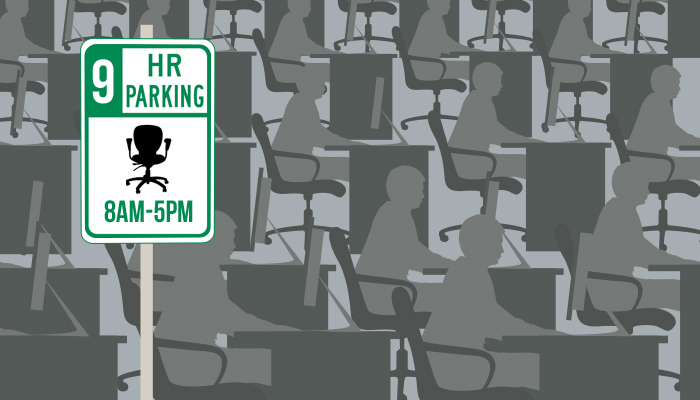Sedentary behavior in the office continues to be a rising concern across urban centers on every continent and highlight an issue that many businesses may not be ready to face. Their workers not only don’t like sitting for so long, they also worry about the negative impact of that sitting.
According to a new On Your Feet Britain survey (conducted by Getbritainstanding.org and the British Heart Foundation (BHF), nearly two-thirds of the 2,000 office workers surveyed were worried sitting at work was having a negative impact on their health. This statistic correlates with results from Ergotron’s JustStand® Index in 2013 which indicated 74% believed sitting so much could lead to an earlier death.
According to Lisa Young, Project Manager for the BHF’s Health at Work Programme, “Too many of us are tied to our desks at work, which could be increasing our risk of developing cardiovascular disease.”
And not only that, research links sedentary behavior to risk of developing Type 2 diabetes, obesity and more. Dr. Frank Booth, of the University of Missouri has identified 26 health risks associated with sedentary behavior.
With viable sit-stand solutions available on the world market to address these concerns, it is perhaps time to ask yourself if your business is ready for a sit-stand workstyle?
A few things need to be in place to support the growing employee awareness of issues like “sitting disease” and their call for a healthier workplace. Not every company can be the Apples of the world, with the creative and adaptive work environments. Most businesses are stuck with rabbit warrens of modular cube construction, undefined budgets for more investment in ergonomics, and no way of knowing if a sit-stand environment would have a meaningful impact on productivity and healthcare costs.
Gavin Bradley, from Get Britain Standing, told the BBC News: “We need new and innovative ways of addressing the issue.”
Here are five ways for your company to get started:
- Design to accommodate sit-stand work environments. Rather than addressing it as an afterthought, bring it forward right at the beginning of a new build or rework. Even if you don’t adopt sit-stand from the start, you will have planned for it down the road. And keep in mind collaborative spaces as well as workstations or conference rooms. Integrating standing options throughout the company helps it become a habitual approach to business.
- Investigate your sit-stand options. Truly, there never was a better time for finding the right workstation to meet any employee need. Take time to find the workstations that fit your decor, technology requirements, and price range, then create a list of approved sit-stand desk options. The key is to have it in place when your employees coming knocking at your door for one.
- Better be prepared because your employees will come knocking. They’ll send you an email. They’ll bring in a doctor’s note. They make their own sit-stand station out of old toner cartridge boxes they find by the printer. Some percentage of your employee population has already heard the sit-stand message and is currently pondering what to do about it. Be ready for them. Here’s one employee’s feedback. Micah R. told us recently: “Just so you know, when I bought the work fit station I was the first person in an office of about 200 people to stand while working. I was worried that I would create problems by doing this, but what has happened has shocked me. Dozens of people have followed my lead and are now standing at work and every year now on my review I get positive feedback on the influence that I have had on my coworkers and my commitment to a healthy lifestyle.”
- Help your hurting employees right away. Nothing sways productivity more than people who are hurting because of their chairs, unable to concentrate or who, all too often, are being whisked away to doctor’s appointments. Giving this population access to sit-stand computing will help them alleviate back strain by allowing frequent posture changes. Studies show it makes a difference. And many employees self-report a reduction in back pain, or a reduction in health related care, like chiropractic visits, when they integrate sit-stand into their work routines.
- Don’t neglect your healthy employees. Incorporate a three to five year strategy for sit-stand work environments into your wellness planning to safeguard healthy employees before they start to hurt. The costs associated with not addressing a worker’s emerging health issues can escalate quickly. Preemptive support to help healthy employees remain healthy has an impact on their productivity and your bottom line.
Where you take it from here will be truly exciting!
It’s not just sit; it’s not just stand. What is becoming very clear now? It’s sit and stand. This postural rotation back and forth is what is associated with the many positive health results we are seeing in existing and emerging research. This is good news for the global community coming to grips with the impact this sedentary behavior is having or will have on our lives.
Our last point could have been: Educate, educate, educate. But in reality, there are many great organizations doing that for you like Getbritainstanding.org, in conjunction with BHF, who are sponsoring the inaugural On Your Feet Britain Day today. A few other organizations with similar bents:
- The American Diabetes Association is claiming May 6 for the Get Fit Don’t Sit Day to raise awareness of the importance of physical activity
- Baker IDI Heart & Diabetes Institute has scheduled June 11 as On Your Feet Australia
When 78% of your work force turns their eye on you regarding this issue, will you be ready?



